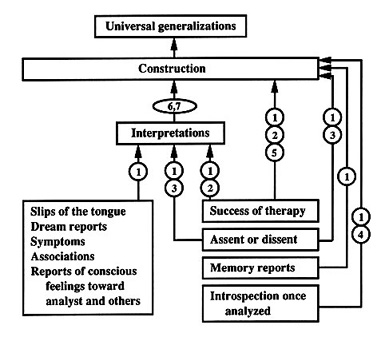Problem 1: Suggestibility
Freud's early work in hypnosis made him keenly aware of the power of suggestion. Recognizing its essential role in an analysis, he even incorporated suggestibility into his theory in the form of transference, the attempt by patients to elicit approval from the analyst as though the analyst were their parent, which "clothes the doctor with authority and is transformed into belief in his communications and explanations" (Freud, 1917, p. 445). Nevertheless, Freud was at pains to distinguish the active ingredient of effective psychoanalysis from the placebo effect of simple suggestibility. Freud believed the active ingredient, rather, to be patients' veridical insight into their problems. Critics hold that transference (suggestibility) is precisely the reason why veridical insight into the pathogens of patients' neuroses is not the therapeutically effective ingredient of an analysis.
The figure below (Von Eckardt, 1986) represents epistemological problems in Freud's use of clinical data as discussed by Grünbaum (1984) (circled numbers correspond to numbered problems at left; arrows represent the relation "is considered evidence for").

LEVELS
PROBLEMS
- suggestibility (pp. 130-135);
- failure of tally argument (pp. 135-172);
- weakness of consilience argument (pp. 273-278);
- Nisbett and Wilson findings (pp. 147-148);
- problems with Breuer-Freud argument (pp. 177-189);
- problems with extrapolation to slips and dreams (pp. 190-239);
- problems with establishing causal claims by retrospective testing (pp. 177-189).
References
Freud, S. (1917). Introductory lectures on psychoanalysis. In J. Strachey (Ed.), The standard edition of the complete works of Sigmund Freud, Vols. 17 and 16. London: Hogarth Press.
Grünbaum, A. (1984). The foundations of psychoanalysis: A philosophical critique. Berkeley, CA: University of California Press.
Von Eckardt, B. (1986). Grünbaum's challenge to Freud's logic of argumentation: A reconstruction and an addendum. The Behavioral and Brain Sciences, 9, 262-263.
Last modified January 1999
Visited times since July 2001
Comments?
Home to Psychoanalysis
Home to Great Ideas in Personality
